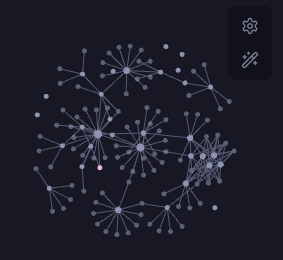2 My Digital Workflow
Connected ideas: Hypermap and Second Brains
I get an idea. I need a place to put that idea. There are lots of options for this, but I use Obsidian. Because it's based on text files and it's locally stored, so if Obsidian the company dissolves, the most recent copy will keep on working just fine, and there's a good chance the community would pick up the project and fork the hell out of it. If Notion goes belly up? Everything there is lost. I have too many ideas stored in my vaults to take that risk.
Obsidian is a container for ideas that can be customized to create very interesting ways to interact with those ideas and see what comes of them. I love the graph view. This particular vault - The Temple of Curious Devotion - is my newest vault. I have several others stored on my laptop and backed up to an external hard drive and two cloud storage solutions.
I started a new vault because I'm doing a bit of a creative and professional pivot. One that's been in the works for a long time, but got stalled when I broke my leg and had to take a year to recover enough to really get creative again.
I'll pull in notes from other vaults over time - part of the Review portion of my workflow is to spend some time processing notes from other vaults to see if I want to move them forward or leave them archived.
There's any number of frameworks you can use for a workflow on your Hypermap/Second Brain, but you do need a workflow otherwise, you're vault is just gonna be a graveyard of ideas. And that's sad.
Capture is one stage of the workflow. Collection is another word for this. Slightly different vibes to each of those words, so use what works for you. The idea is that you need to get the ideas out of your head and into a form that you can physically/digitally manipulate. Then there's the ideas you stumble across on the web, in conversations, in classes, etc. That's why "writing" doesn't really work as a label here - right now, I'm writing, yes, but other notes have embeds and citations that were snipped from elsewhere. Capture. Collect. Whichever works for you.
I thought about putting Curation with Capture/Collect, but Curation is really it's own part of the workflow. You've captured the ideas and collected them into a space where those ideas can be connected. But you have to curate those connections. Obsidian is GREAT for this. Other tools work, too, so explore as many as you need to explore to find what clicks for you. Obsidian works for me because it gives me LOTS of different ways to curate and remix various ideas to spark new ideas.
The graph view is one obvious option. This particular image is a screenshot of the graph view of this particular vault, showing connections between notes starting to develop and hubs of thought starting to emerge.

I also like to turn on the random note feature. You get a little dice icon in the left toolbar, hit that and a random note comes up. Reread it, edit it, add to it, see what tangents it takes you on. Do that regularly enough, you start to build up a ton of connections.
Obsidian also gives a variety of ways to organize and connect your notes. You can sort them into folders to make finding particular notes easier. You can also add tags - then turn on tags display in your graph view and the tags will show up, at which point, you can click a tag and it'll show you a list of every note holding that tag - connections waiting to be made.
Then there's linking. Put brackets around a word or phrase to turn it into a link. If a note by that name exists, it'll be a live link, otherwise, it'll be a ghost link and you just have to click on it to create a note by that name. Part of my review process when going through random notes is adding more links to create new tangents and connections.
As I keep doing this day after day, capture and curation, ideas start to grow. Our Augmented Minds is the biggest idea in this vault so far - not surprising since that's my main Substack focus right now. As my curiosity shifts to other interests, those ideas will begin to grow as well, and I won't have to worry about losing any of them because I've got them in a basic text file format with multiple backups and if we're at a point where I can't access ANY of my data, I'll have way more to worry about than lost notes.